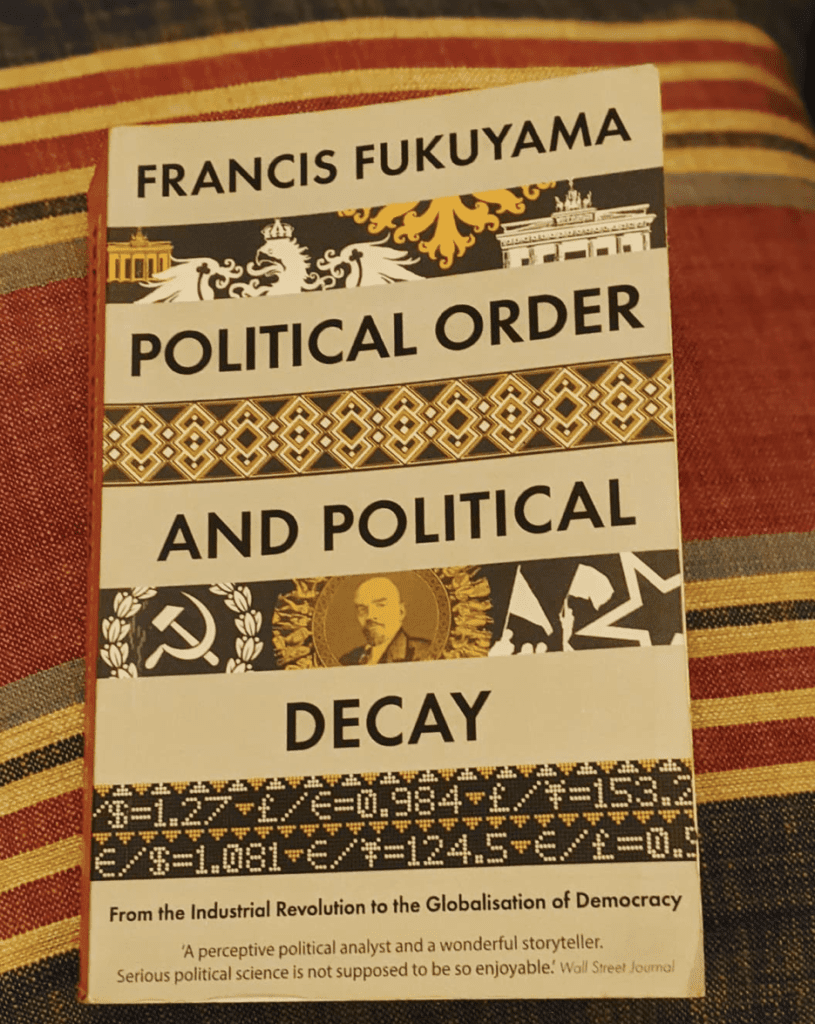Francis Fukuyama
The first volume – The Origins of Political Order – went straight into my favourites, and so does this one. While the former was about the components of a stable state, and how political institutions developed differently in various parts of the world, this book begins at the dawn of the Industrial Revolution and shows how state, law and democracy developed to their current state, by (also) considering three additional dimensions of socioeconomic development – social mobilisation, idea legitimacy, and economic development. The industrial revolution and the economic growth that followed caused a movement to urban areas, where new social groups were formed based on fluid identities. This mobilisation serves as a foundation for changing political institutions with new ideas. The book also throws light on the various reasons for the decay of institutions, and offers directional thoughts on fixing them.
The author frames the development of the stable state by asking how a country can “get to Denmark”, which is the benchmark for an ideal state. While there is some specific focus on the US, also warranted by its early and unique path to democracy, the depth of analysis that has gone into many countries, across Asia, Latin America, Africa, Europe, is just astounding! History, economics, policy, geography, (with critique and usage of content from another favourite book – Guns, Germs & Steel), culture and many other facets, all going into understanding the state of politics in a particular country. There are many routes to modern government, including the necessities that war creates (“unfortunately”, Latin America never had its share, and Europe had plenty of it – both have class stratification, national identity, and geography to thank) and peaceful political reform. And once there, the principle of effective government is meritocracy, the principle of democracy is popular participation, effective states operate through law, but law can be an obstacle to appropriate levels of administrative discretion – how is balance achieved? The material is phenomenally complicated, and bringing it to this level of accessibility is something the author should be credited for.
The first part of the book focuses on parts of the world that experienced liberal democracies first – Europe and the US. It also analyses why Germany has an uncorrupt administration while Italy and Greece are plagued by corruption. In the former, how is state strength related to organised crime? How does cynicism and social distrust get culturally embedded? How were Britain and the US able to reform themselves from patronage-led public sectors? And why was Britain able to get there faster than the US? An active middle class accelerated Britain while US got a unified business community and middle class professionals only in the late nineteenth century. At a broad level, we learn early that the sequencing of events matters greatly. Countries where democracy preceded state-building (US) have had higher problems in achieving high-quality governance than those who inherited modern states (Germany, through some excellent civil service reform and an educational system) from absolutists. And that democratic societies without a strong national identity have trouble unifying the population with a common narrative.
The second part deals with parts of the world that had been colonised – Latin America, Asia, Africa, and the Middle East. When the imperial powers left, many of these nations were neither fully Westernised nor able to retain their traditional political organisation. However, there are success stories like Costa Rica, which according to many frameworks should have become a banana republic. There are also disasters, like Argentina, which, blessed with climate and resources, should have become a model country. The reasons are complex, and Sub-Saharan Africa vs East Asia is a great example of different development paths. In both areas, as well as Latin America and the Middle East, states that had strong institutions were able to reestablish them, while those that didn’t struggled. Interesting to note that African ethnic groups are largely a modern phenomenon, created or at least consolidated in postcolonial times! The specifics of the Japanese system and how their military-led nationalism has evolved until the present day is also fascinating. The problem that East Asia now faces is making the state accountable. The nuanced difference between rule by law (state using law for its ends) and rule of law (law binding on the state) is superbly explained. In the Middle East, the threat is that popular mobilisations risks being hijacked by religion.
Part 3 focuses on democratic accountability and goes back in time to the period after the French and American revolutions to see how democracy spread. The timing in various countries vary depending on the changing relative positions of social classes – middle class, working class, elites, and peasants. The rise and growth of middle class was a great catalyst to democracy. While doing this, it raises a question extremely important for the current times – with increasing globalisation and technological advances, the middle class is getting hollowed out. What happens to democracy then?
The final section of the book is on political decay, and there is a heavy focus on the US, which has now gotten tied up in the very checks and balances it had set up to protect democracy. In the author’s words, “there is too much law and too much “democracy” relative to the American state capacity”. It has now become a vetocracy, with economically powerful special interest groups and the judicial arm having hijacked the system and preventing reforms. No modern book can avoid China, and this is further proof. The author sees the Chinese model as the biggest nondemocratic challenge to the idea of liberalised democracies. How will the Chinese middle class behaves in the next few decades? Even as it grows, will it be content to live under a “benevolent” one-party dictatorship?
I think I will re-read both volumes, they are such treasure troves of information. If you like books that explain the system of the world, this is a set you most definitely should pick up.

